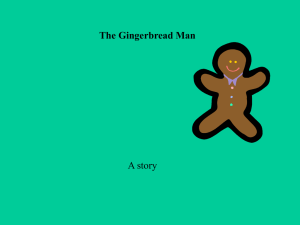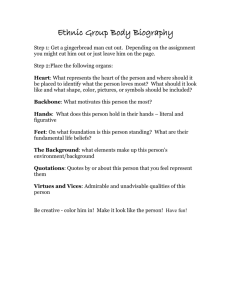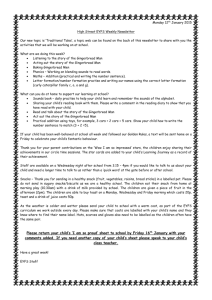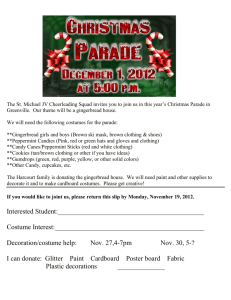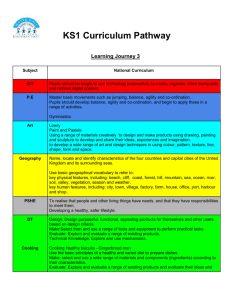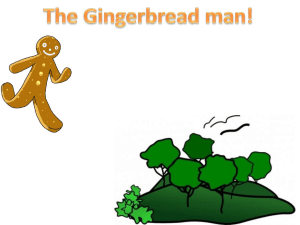Study Guide - Birmingham Children's Theatre
advertisement
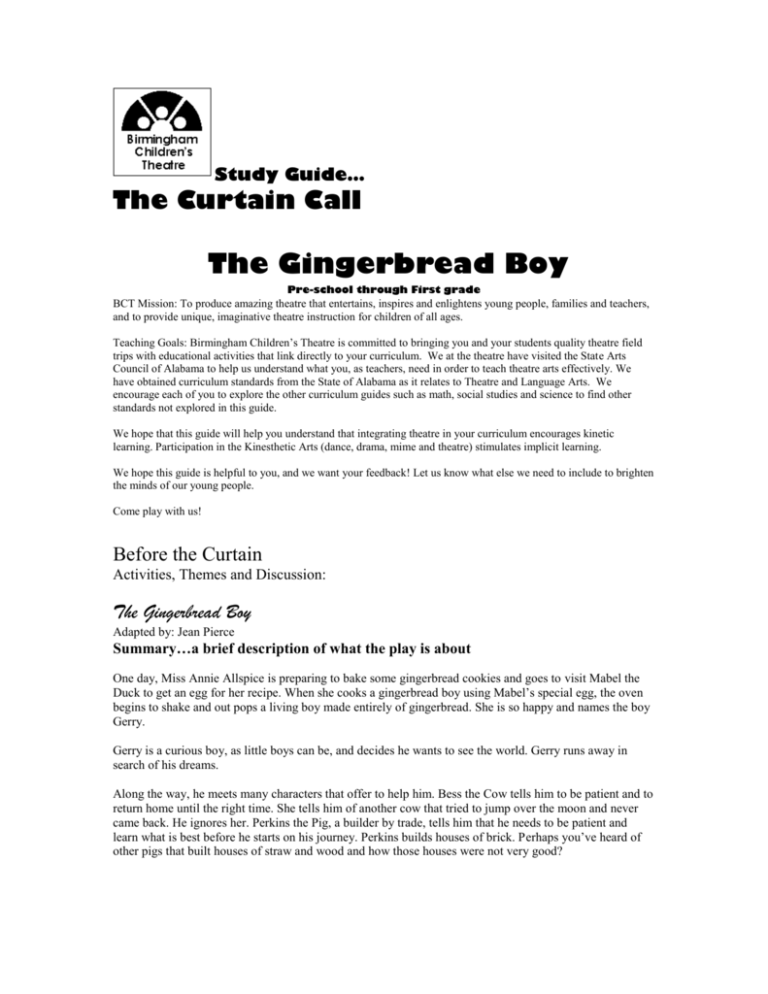
Study Guide… The Curtain Call The Gingerbread Boy Pre-school through First grade BCT Mission: To produce amazing theatre that entertains, inspires and enlightens young people, families and teachers, and to provide unique, imaginative theatre instruction for children of all ages. Teaching Goals: Birmingham Children’s Theatre is committed to bringing you and your students quality theatre field trips with educational activities that link directly to your curriculum. We at the theatre have visited the State Arts Council of Alabama to help us understand what you, as teachers, need in order to teach theatre arts effectively. We have obtained curriculum standards from the State of Alabama as it relates to Theatre and Language Arts. We encourage each of you to explore the other curriculum guides such as math, social studies and science to find other standards not explored in this guide. We hope that this guide will help you understand that integrating theatre in your curriculum encourages kinetic learning. Participation in the Kinesthetic Arts (dance, drama, mime and theatre) stimulates implicit learning. We hope this guide is helpful to you, and we want your feedback! Let us know what else we need to include to brighten the minds of our young people. Come play with us! Before the Curtain Activities, Themes and Discussion: The Gingerbread Boy Adapted by: Jean Pierce Summary…a brief description of what the play is about One day, Miss Annie Allspice is preparing to bake some gingerbread cookies and goes to visit Mabel the Duck to get an egg for her recipe. When she cooks a gingerbread boy using Mabel’s special egg, the oven begins to shake and out pops a living boy made entirely of gingerbread. She is so happy and names the boy Gerry. Gerry is a curious boy, as little boys can be, and decides he wants to see the world. Gerry runs away in search of his dreams. Along the way, he meets many characters that offer to help him. Bess the Cow tells him to be patient and to return home until the right time. She tells him of another cow that tried to jump over the moon and never came back. He ignores her. Perkins the Pig, a builder by trade, tells him that he needs to be patient and learn what is best before he starts on his journey. Perkins builds houses of brick. Perhaps you’ve heard of other pigs that built houses of straw and wood and how those houses were not very good? Gerry eventually meets Findley the Fox who offers to help him achieve his goals. Gerry is so happy to finally meet a friend. However, things are not always as they appear. He has heard of Miss Annie’s skill at baking and really wants to eat the cookie. Will Miss Annie find Gerry before the mischievous fox eats him? Will Gerry learn the valuable lesson that will make him a “smart cookie”? You’ll have to wait for the ending to see for sure but a “smart cookie” is someone who is willing to take good advice. About the Playwright: Jean Pierce What made you want to write? I read or was read to from early childhood. My head was so full of the words of authors and poets I wanted to try it myself. My first efforts were poems. Rhyme and rhythm still delight me. I suppose that’s why I gravitate to musicals. Writing song lyrics is one of the most fulfilling aspects of creating a play. What books and authors did you read as a child? I was a child in the 1930s. Winnie the Pooh and Christopher Robin Poem Books by A. A. Milne, Folk and Fairy Tales from the Brothers Grimm and Hans Christian Anderson, Myth and Enchantment Tales by Margaret Evans Price, A Child’s Garden of Verses by Robert Louis Stevenson, Peter Pan by James M. Barrie, and Alice in Wonderland by Lewis Carroll. Wonderful illustrations by Maxfield Parrish (Arabian Nights) and N.C Wyeth (Treasure Island) added much to the magic of reading. *Why did you choose to change the ending of the original Gingerbread Boy? I am in favor of happy endings for young theatergoers. The experience should leave the audience happy and hopeful. A scary escape is exciting and a lesson learned is essential but the hero, even though he is just a cookie, must survive. The Gingerbread Boy will not be eaten! Why did you want to make the storybook into a play? Perhaps some stories are better imagined, but the Gingerbread Boy was a natural for the theatre. Costuming played a large part. Once a “cookie boy” was created by the costumer, his adventures were such fun to watch that the story took on a new life. How do you turn a story into a play? From “the page to the stage”: that is the challenge. Often the story is so short that it needs expanding and embellishing. Other events and adventures may be added. (plot) The characters must speak for themselves in order to tell the story. (dialogue) The original story should be recognizable but our audience will accept changes if I enhance the story and make the characters more believable and more human. All Wee Folks plays should be lighthearted and fun (style), though I always include a message, usually one involving a change in behavior. *For discussion after the play Ingredients for a yummy audience What do you think it takes to be a good audience member? The audience is a very important ingredient to a great performance. You can actually make the play better by being a good listener and by using your delicious imaginations. Here are some tips that will help Annie Allspice, the Gingerbread Boy and the other characters give you a scrumptious show! -When you arrive at the theatre, please stay on your bus until a BCT representative greets you. -Once seated in the theatre, please sit crisscross applesauce with your hands in your lap. -During the performance, please stay seated. -The actors love to hear your laughter when they do or say something funny, but please no talking or whispering during the performance unless you are helping the actors. -Absolutely no gum, eating or drinking inside of the theatre. -No cameras or recording devices may be used during a performance. -Please turn off all cell phones and beepers. -Actors love to hear applause! Show your appreciation by clapping at the end of the play. The History of The Gingerbread Boy…how we first heard of the story The Gingerbread Boy is the retelling of an old folk tale that probably began in England. When the story was first told in Colonial America it was called Johnny Cake. Other countries also have their own versions of the tale. Norway’s story is known as The Pancake while the German version is known as The Runaway Pancake. The Bulgarian version is called the Round Cake of Wheat and Russia’s version is known as The Bun. There are also more recent versions and adaptations within the United States including a MexicanAmerican retelling The Runaway Tortilla set in Texas and The Cajun Gingerbread Boy from Louisiana. A Hawaiian version called the Musubi Man and Chinese New Year tale called The Runaway Rice Cake are other funny titles. Regardless of where the story is told, all versions tell the story of a cookie coming to life and fleeing across the countryside to escape being eaten. The Gingerbread Boy has always been a favorite for children everywhere. Biography…where we found our information on the history of The Gingerbread Boy *Asbjornsen, Peter Christen. The Runaway Pancake. Larousse & Co., 1980. *Amoss, Berthe. The Cajun Gingerbread Boy. MTC press, 1996. *Barrett, Valerie. The Complete Book of Gingerbread: Traditional Gingerbread Recipes and Designs from Around the World. Chartwell Books, 1992. *Brett, Jan. Gingerbread Baby. G.P. Putnam’s Sons, 1999. *Brown, Marcia. The Bun: A Tale from Russia. Harcourt Young Classics, 1972. *Cauley, Lorinda Bryan. The Pancake Boy: An Old Norwegian Folktale. Putnam, 1988. *Compestine, Ying Chang. The Runaway Rice Cake. Simon &Schuster, 2001. *Egielski, Richard. The Gingerbread Boy. Harpercollins Juvenile Books, 1997. *Galdone, Paul. The Gingerbread Boy. Clarion Books, 1975. *Kimmel, Eric A. The Runaway Tortilla. Winslow Press, 2000. Gingerbread Boy Cookies Ask an adult to let you shop with them for these ingredients. Check you kitchen cabinets first. Make a list of what you have and then make another list of what you need. If you don’t have a gingerbread boy cookie cutter, make a cookie stencil. Trace the shape on cardboard. Have an adult help you cut it out. Once the dough is rolled and ready to cut, lay the stencil on top and have an adult cut around it with a sharp knife. Ingredients: 1 cup butter 1 cup sugar ½ teaspoon salt 1 cup molasses 2 tablespoons white vinegar 1 large egg 5 cups all-purpose flour 1 ½ teaspoons baking soda 1 tablespoon ground ginger 1 teaspoon ground cinnamon 1 teaspoon ground cloves Beat butter at medium speed with an electric mixer until creamy; gradually add sugar and salt, beating well. Add molasses, vinegar, and egg, beating at low speed just until blended. Combine flour and next 4 ingredients; add to butter mixture, beating at low speed until blended. Cover and chill 8 hours. Divide dough into fourths. Roll each portion to a 1/8-inch thickness on a floured surface. Cut with a 3-inch gingerbread cookie cutter. Place on lightly greased or parchment paper-lined baking sheets. Bake at 375 degrees for 8 minutes. Cool on pans 1 minute (this allows cookies to lift easily off of pan); then place on wire racks to cool. Decorate as desired. Yield: Makes 6 dozen, Southern Living, November 2002 For Discussion: If you were a cookie what kind would you be and why? What would you do if you took cookies out of the oven and they started talking to you? What do you imagine Annie Allspice’s kitchen to look like? Birmingham Children’s Theatre uses artists called designers to draw a set and costumes before they are actually built or sewn. Designers work with the person that wrote the play called the playwright and they use their imaginations to make up what they think the sets and costumes should look like. Use your imagination to draw what you think Annie Allspice’s kitchen should look like: Post Play Activities, Themes, Discussion: Encore Activities, themes and discussion: Puppet Making Poem We hope our play brought you much fun Man, that Gingerbread Boy could run! Delicious cookies Annie Allspice did bake While creative puppets you shall make. Using paper bags, artsy supplies and clever plans You will bring your puppet to life with your talented hands. Will you design Annie, a wolf, a pig or cow? Any character will make your audience say, “wow!” Instructions: Break the class into groups of 5 students. Have them create animals or cookies out of the bags. Then let them put on their own Gingerbread Boy play using the puppets. Allow them to make up their own lines and drama – let the story stray wildly into time and space. Have them make up new endings. Ask the children why they chose a particular puppet, story line and ending. For Discussion: How did the costumes help you know which animal was which? Who was your favorite character and why? How was the wolf different from the other characters? What happened to The Gingerbread Boy because he didn’t listen to good advice? Can you think of a time when you didn’t listen to good advice? What happened and why? How did The Gingerbread Boy’s actions make you feel? How did the wolf make you feel? Which part of the play did you enjoy most? What was the funniest part? How did the lights, costumes and set help tell the story? For Further consideration: Have the class make up different characters and act out a play that they write. Using only props and costuming (desk supplies, coats, scarves, poster board, etc) in the classroom have them improvise their lines based on what type of character they become. For example, if a student wants to be a Martian, have him or her describe the feelings and characteristics before you begin. If the child improvises out -of -character, have them explain why the nice Martian is suddenly mad – what has happened to make it angry? What is the conflict? How is the conflict resolved? How does the character feel at the end of the play? Meeting Language Art Content Standards and Theatre Content Standards in Alabama The Summary meets these requirements: Language Arts – K:12, K:14, K:15, 1:6, 1:13, 1:16 Ingredients for a Yummy Audience meets these requirements: LA –K:15, 16 T – K:8, K:9, 1:9, 1:10 The History meets these requirements: LA – K:11, K:12, 1:10 Gingerbread Boy Recipe – Please look up curriculum standards for math and science For Discussion (both pre-play and post-play sections) meet these requirements: LA – K:1, K:12, K:13, K:14, K:15, K:17, K:18, K:23, 1:1, 1:6, 1:13, 1:16, 1:18, 1:24 T – K:1, K:4, K:5, K:6, K:7, 1:1,1:4, 1:6, 1:7, 1:8 Drawing Annie Allspice’s Kitchen, Re-telling The Gingerbread Boy using only pictures and Draw your favorite character in costume meet these requirements: LA – K:1, K:18, K:19, K:20, K:23, 1:1, 1:6, 1:18, 1:24 T – K:5, 1:5, 1:6 Puppet Making meets these requirements: LA – K:1, K:13, K:14, K:15, K:18, K:23, 1:1, 1:6, 1:16, 1:24 T – K:5, 1:15, 1:16 *Please send your pictures, stories, writing, or comments to our actors! They love hearing from the kids and everyone at BCT loves seeing their artwork – It will be on display at our office Can you retell The Gingerbread Boy using only pictures? Draw your favorite character in costume.
